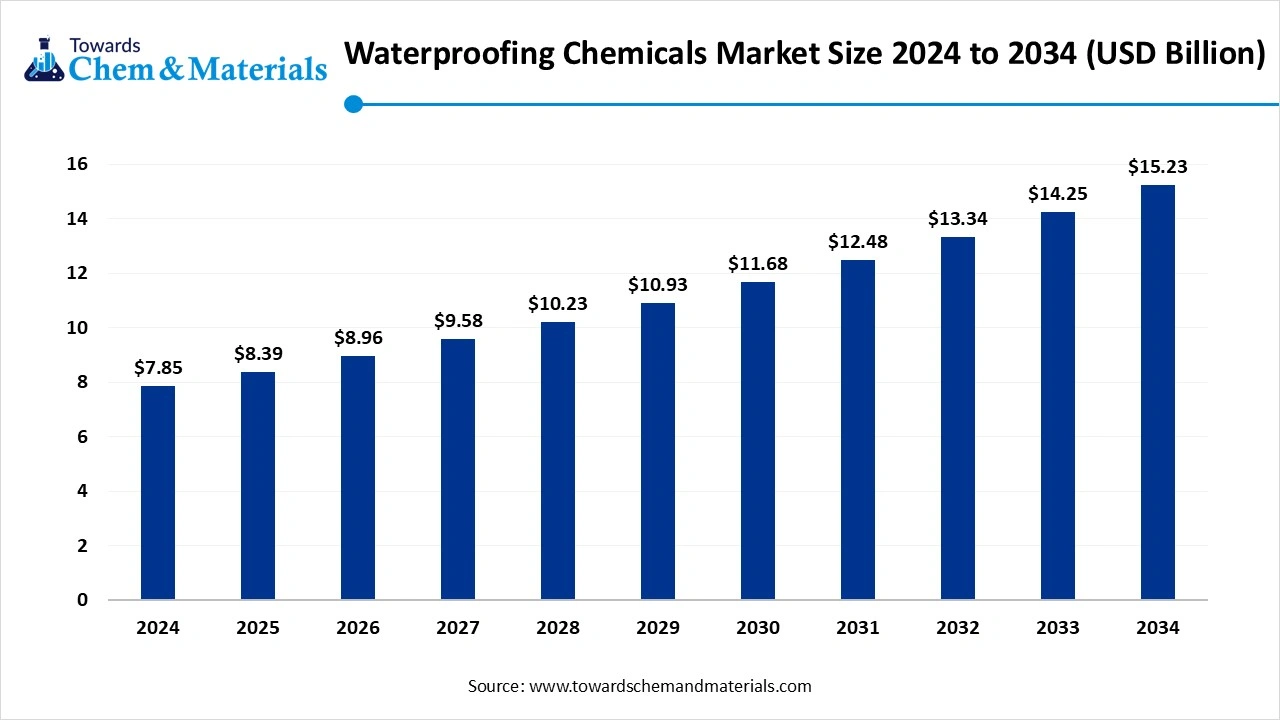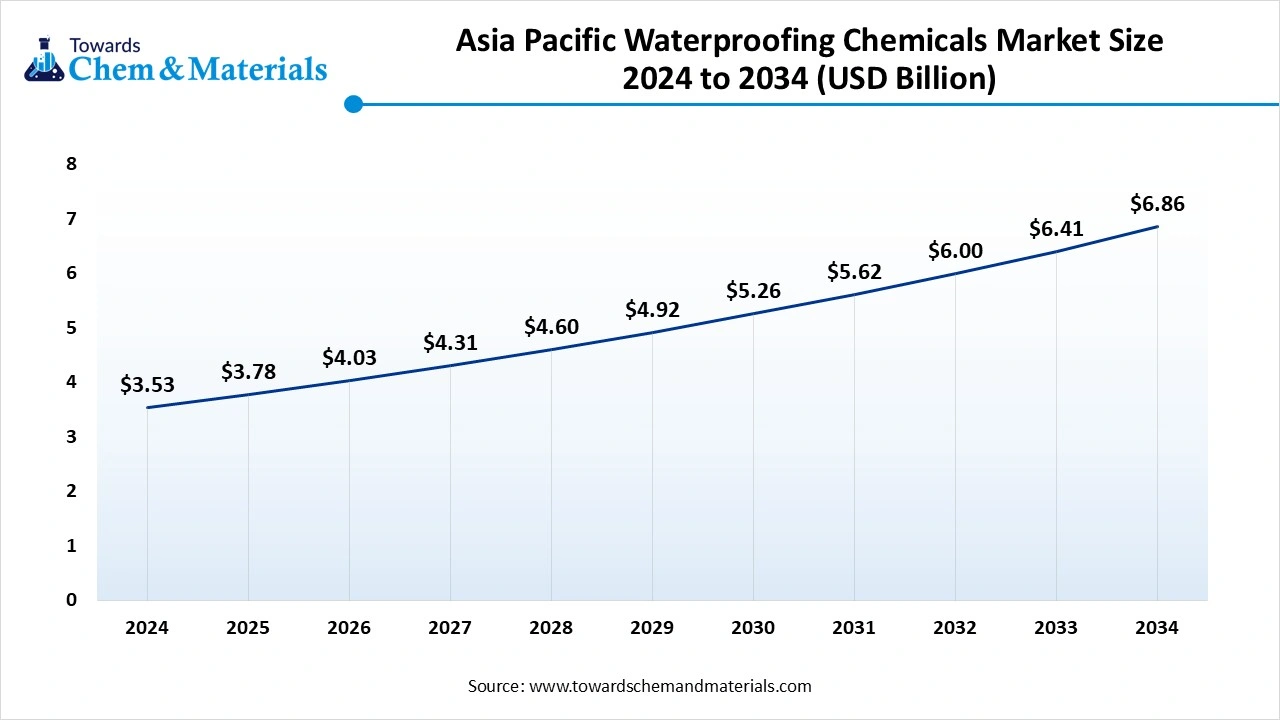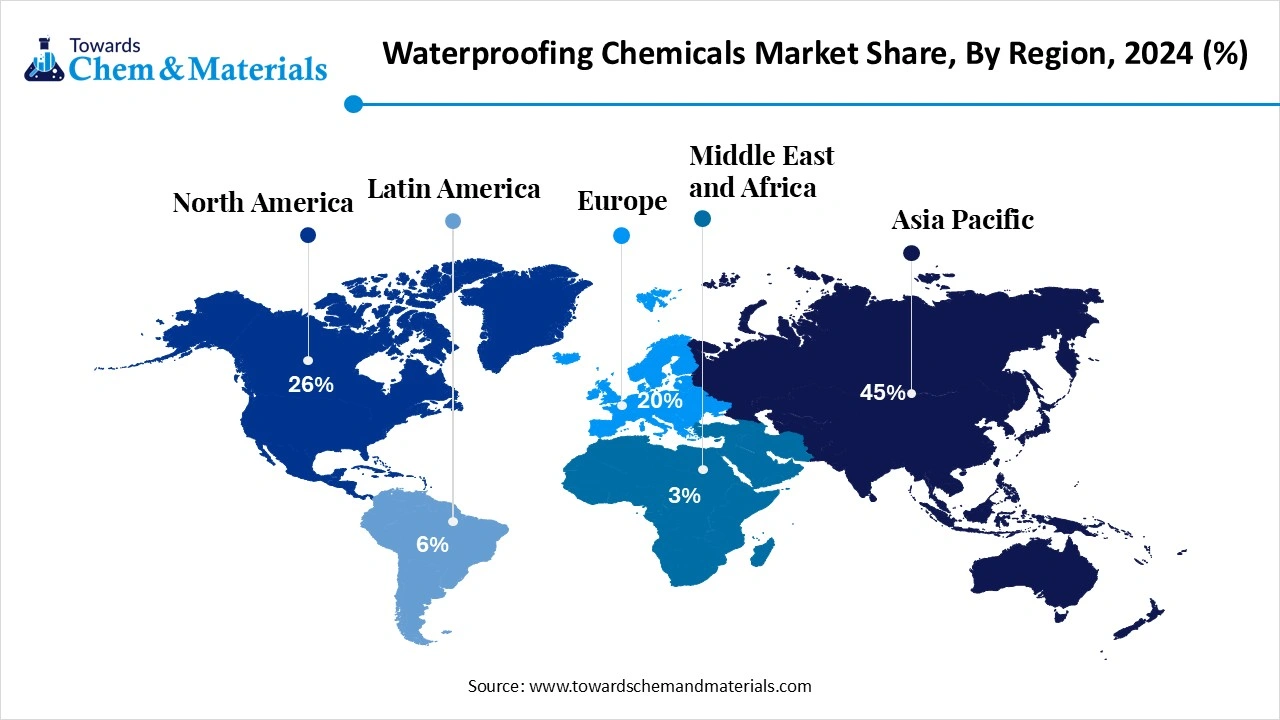November 2025
The waterproofing chemicals market size accounted for USD 7.85 billion in 2024 and is predicted to increase from USD 8.39 billion in 2025 to approximately USD 15.23 billion by 2034, expanding at a CAGR of 6.85% from 2025 to 2034.
The growth of the market is driven by the growing construction and infrastructure development due to rapid urbanization and increased awareness, aligning with government initiatives, which drive the growth of the market.

The waterproofing chemicals market is important because these materials shield buildings and infrastructure from water damage, enhancing durability, safety, and lifespan.
Market growth is driven by rapid urbanization, demands for climate resilience, technological advancements, increased infrastructure projects, and a global move towards sustainable building methods. These chemicals help prevent expensive structural issues like cracks and mold, reducing maintenance costs and supporting more sustainable construction.
| Report Attributes | Details |
| Market Size in 2025 | USD 8.39 Billion |
| Expected Size by 2034 | USD 15.23 Billion |
| Growth Rate from 2025 to 2034 | CAGR 6.85% |
| Base Year of Estimation | 2024 |
| Forecast Period | 2025 - 2034 |
| Dominant Region | Asia Pacific |
| Segment Covered | By Product Type, By Application Area, By End-use Sector, By Distribution Channel, By Performance Requirement, By Region |
| Key Companies Profiled | RPM International (Tremco, Carboline) , Pidilite Industries , Asian Paints , Jotun , Saint-Gobain Weber , Ardex , Carlisle Companies , Kryton International , Soudal , Wacker Chemie , Kemper System , Kerakoll , H.B. Fuller , Huntsman Corporation , Soprema |
The key technological shifts in the market include the growing focus on the development of eco-friendly solutions like biobased chemicals and low-VOC materials, with advanced technology aligning with the innovation by development of high-performance materials using technologies such as nanotechnology, with properties such as self-healing and hybrid formulation.
The integration of AI and IoT for enhancing the performance and process optimization for real-time monitoring and predictive maintenance creates an opportunity for growth.
| Country / Region | Regulatory Body | Key Regulations | Focus Areas | Notable Notes |
| United States | U.S. EPA (Environmental Protection Agency), OSHA, ASTM International | - EPA Clean Air Act (VOC limits for coatings/adhesives) - OSHA Hazard Communication Standard (GHS alignment) - ASTM C836/C898 (standards for liquid-applied membranes) |
- Worker safety - VOC content and emissions - Performance of waterproofing systems |
Green building codes (LEED, Energy Star) encourage low-VOC waterproofing products. ASTM widely governs material performance. |
| European Union | ECHA (European Chemicals Agency), CEN | - REACH (chemical safety and registration) - CLP Regulation (classification & labeling) - EN 1504-2 (products for protection and repair of concrete) |
- Environmental compliance - Hazard labeling - Building material standards |
EU drives stricter VOC restrictions. Sustainability requirements under the EU Green Deal affect waterproofing formulations. |
| China | Ministry of Ecology and Environment (MEE), SAC (Standardization Administration of China) | - GB/T 23445 (polymer waterproof sheets) - GB/T 328.10 (liquid-applied membranes) - MEE Order No. 12 (chemical registration) |
- Product performance - New chemical notification - Construction safety |
Waterproofing chemicals must meet both chemical and building material standards. Strong push toward eco-friendly waterproofing systems. |
| India | BIS (Bureau of Indian Standards), MoEFCC (Ministry of Environment, Forest and Climate Change) | - IS 2645 (integral waterproofing compounds) - IS 15491 (polymer-modified bitumen membranes) - Draft Chemicals (Management & Safety) Rules, 2020 |
- Building durability - Hazard communication - Import & trade compliance |
Waterproofing materials must be BIS-certified. India is moving toward REACH-like chemical regulation, which will affect raw material sourcing. |
| Japan | JIS (Japanese Industrial Standards), MLIT (Ministry of Land, Infrastructure, Transport and Tourism) | - JIS A 6021 (liquid-applied waterproofing membranes) - JIS A 6008 (polymer sheets for waterproofing) |
- Material testing - Construction safety - Chemical safety |
Japan emphasizes long-term durability and seismic-resilient construction. Eco-friendly waterproofing solutions are gaining importance under green building policies. |
Which Product Type Segment Dominated The Waterproofing Chemicals Market In 2024?
The liquid-applied membranes – single components segment dominated the market with a share of 35% in 2024. They are gaining popularity due to their ease of application, cost-effectiveness, and suitability for small to medium-scale projects.
These membranes are widely used in commercial and residential roofing as well as smaller infrastructure works where quick installation is required. Their user-friendly application reduces labor costs, making them particularly attractive in emerging markets. Growth in residential renovation activities and demand for reliable waterproofing in humid climates are driving the adoption of this product type.
The liquid-applied membranes two-component segment expects significant growth in the waterproofing chemicals market during the forecast period. It provides higher durability, flexibility, and chemical resistance compared to single-component types. They are preferred in large-scale projects such as podium decks, bridges, and public infrastructure, where long-term performance is critical.
Although the application requires skilled labor, the membranes deliver superior crack-bridging capabilities and adhesion, making them ideal for challenging construction environments. Increasing investments in infrastructure modernization and demand for high-performance waterproofing solutions are accelerating the uptake of two-component systems globally.
How Did the Roofing Segment Dominated The Waterproofing Chemicals Market In 2024?
The roofing segment dominated the market with a share of 22% in 2024. Roofing remains the largest application area for waterproofing chemicals, accounting for a significant share of demand. Exposure to weather extremes, heavy rainfall, and temperature fluctuations makes roofing surfaces highly vulnerable to leaks and cracks.
The increasing adoption of energy-efficient and green building standards is also influencing the demand for high-performance, sustainable waterproofing solutions in roofing applications across both developed and emerging economies.
The balconies & podium decks segment expects significant growth in the waterproofing chemicals market during the forecast period. Balconies and podium decks require specialized waterproofing solutions to prevent water ingress and structural damage caused by frequent exposure to rain and moisture. Podium decks in urban complexes, shopping malls, and commercial buildings demand durable membranes with strong load-bearing capacity and flexibility. Enhanced aesthetic requirements are also pushing innovation in fast-curing and seamless waterproofing technologies.
Which End Use Sector Segment Dominated The Waterproofing Chemicals Market In 2024?
The commercial buildings segment dominated the market with a share of 32% in 2024. Commercial buildings such as office complexes, retail centers, and hospitality establishments are major consumers of waterproofing chemicals.
These structures require long-lasting protection against water infiltration to preserve assets and maintain aesthetic value. Additionally, compliance with building safety codes and sustainability standards is influencing the selection of environmentally friendly, high-performance waterproofing membranes in this sector.
The infrastructure & public works segment expects significant growth in the market during the forecast period. Infrastructure and public works, including bridges, tunnels, highways, and water management systems, represent a fast-growing application area for waterproofing chemicals.
Governments worldwide are investing in infrastructure upgrades and new projects, driving substantial demand for waterproofing materials. Public sector projects also emphasize long-term performance, ensuring minimal maintenance costs, which boosts the adoption of premium, two-component liquid-applied membranes and advanced formulations.
How Did the Direct Project Sales Segment Dominated The Waterproofing Chemicals Market In 2024?
The direct project sales segment dominated the market with a share of 42% in 2024. Direct project sales dominate the market, especially in large-scale commercial and infrastructure projects. Manufacturers and suppliers collaborate directly with construction companies, architects, and contractors to provide tailored solutions.
The growth of mega-infrastructure projects, particularly in the Asia Pacific and the Middle East, is reinforcing the importance of direct sales, as large buyers prefer negotiated contracts with guaranteed product quality and supply continuity.
The online/e-commerce segment expects significant growth in the waterproofing chemicals market during the forecast period. The online and e-commerce distribution channel is expanding rapidly, driven by the increasing demand from small contractors, retailers, and DIY consumers.
This channel is particularly beneficial for single-component liquid membranes used in smaller residential repairs. The convenience of online platforms, combined with rising digital adoption in the construction materials sector, is expected to accelerate growth in this distribution segment.
Which Performance Requirement Segment Dominated The Waterproofing Chemicals Market In 2024?
The high-flexibility/crack-bridging segment dominated the market with a share of 30% in 2024. High flexibility and crack-bridging properties are critical in waterproofing applications where structures face thermal expansion, vibrations, or structural movement. These membranes are commonly used in infrastructure works and podium decks to ensure long-term durability.
The demand is rising in regions prone to seismic activity or extreme climate variations, where standard membranes fail to perform. Advanced formulations with elastomeric properties are being developed to meet these requirements, ensuring resilience and extended lifecycle performance.
The fast-curing/rapid return-to-service segment expects significant growth in the market during the forecast period. Fast-curing membranes are increasingly in demand for projects with tight deadlines or those requiring minimal downtime, such as commercial renovations and public infrastructure upgrades.
These products enable quick installation and reduce disruption in service areas like shopping malls, office complexes, and public facilities. With urban infrastructure projects growing rapidly, contractors are prioritizing solutions that balance durability with speed of application. Manufacturers are responding with advanced polymer-modified systems that allow rapid curing without compromising performance.
Asia Pacific Waterproofing Chemicals Market Size, Industry Report 2034
The Asia Pacific waterproofing chemicals market size was valued at USD 3.53 billion in 2024 and is expected to surpass around USD 6.86 billion by 2034, expanding at a compound annual growth rate (CAGR) of 6.87% over the forecast period from 2025 to 2034. Asia Pacific dominated the waterproofing chemicals market in 2024.

The growth of the market is driven by the rapid urbanization and infrastructure development in the region, due to increased investments by the government, which help in the growth of the market. The increased construction activities in the region and demand for both industrial and commercial sectors increase the demand for waterproofing solutions. The growing focus on climate change and sustainability demand in the region further contributes to the growth and expansion of the market.

India Has Seen Growth Due To The Presence Of Significant Players In The Market
India has seen significant growth, driven by the presence of key players in the country like Pidilite Industries, Sika AG, Sunanda Global, CICO Group, and Fosroc, which increases the demand for the market, resulting from growing construction activity in the country due to rising demand, which fuels the growth of the market in the region.
North America Has Seen Significant Growth, Driven By Infrastructure Development
North America is expected to experience significant growth in the market in the forecast period. The growth of the market is driven by demand for infrastructure renewal and maintenance to increase the life of buildings and structures against water infiltration, which drives the growth of the market in the region. The growing awareness of the importance of protecting structures from costly water damage fosters widespread adoption of these products in the region, driving the growth and expansion of the market.
By Product Type
By Application Area
By End-use Sector
By Distribution Channel
By Performance Requirement
By Region
November 2025
November 2025
November 2025
November 2025